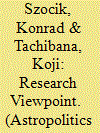|
|
|
Sort Order |
|
|
|
Items / Page
|
|
|
|
|
|
|
| Srl | Item |
| 1 |
ID:
169970


|
|
|
|
|
| Summary/Abstract |
How do the three major schools of international relations theory – liberal internationalism, realism, and constructivism – account for the second space race, the rivalry between China and the United States to scientifically explore and economically develop the Moon? This article assesses answers drawn from these three schools of international relations. Rather than distance from the Earth, surface area, and resource endowment, it is the lack of native population and status as a commons in international law that make the Moon a novel object of international relations. From the perspectives of both liberal internationalism and constructivism, the Sino-American rivalry represents failure. International institutions and organizations, which were established to extend the liberal world order into outer space, failed in this case to restrain the behavior of China and the United States. The diplomatic communication between Chinese and American national decision-makers failed to draw them into adherence with the norm of international cooperation encoded in those international institutions and organizations. By contrast, realism accounts for the second space race as an example of balancing of power. National decision-makers ignored international institutions and organizations together with international norms to gain or not lose relative international prestige, business opportunity, and potential economic growth.
|
|
|
|
|
|
|
|
|
|
|
|
|
|
|
|
| 2 |
ID:
169971


|
|
|
|
|
| Summary/Abstract |
There is a natural process that major technological activities are in a first stage supported by governments and later evolve into commercial and private activities. Space activities are a present example of this and this process is now also taking place in China. One of the prerequisites to commercial activities is flexibility in regulations, particularly export controls and technology transfer. The Chinese government is accelerating the adaption of regulations to facilitate the growth of the Chinese commercial space sector. An overview of this process, including the status and listing of the present regulations, is given in this paper. The success of this process is demonstrated by recent commercial space activities in China illustrating that there is a trend towards promoting such activities supported by the government. This paper conducts research and discussion on the Chinese space sector and its international cooperation in the field of legal implications, governance, and cooperation. It provides an understanding of evolving Chinese space regulations and the growth of present Chinese commercial space activities.
|
|
|
|
|
|
|
|
|
|
|
|
|
|
|
|
| 3 |
ID:
169972


|
|
|
|
|
| Summary/Abstract |
This paper discusses key issues concerning robotic space missions and human enhancement for purposes of missions to deep space. Effective robotic exploration, especially to deep space, optimally requires advanced artificial intelligence not currently employed. This posits ethical and social challenges in interactions with humans. It is also argued that exploration of deep space by humans ideally requires physiological enhancement of future astronauts. At the same time, progress in space medicine, countermeasures to space radiation, and artificial gravity also provide solutions for deep space human missions. The paper concludes that deep space mission planners seriously account for both advanced robotic artificial intelligence and human physiological enhancement.
|
|
|
|
|
|
|
|
|
|
|
|
|
|
|
|
| 4 |
ID:
169969


|
|
|
|
|
| Summary/Abstract |
Indian Prime Minister Narendra Modi announced support for a human spaceflight program during his 2018 Independence Day speech. The target year of 2022 is when India plans to realize its first indigenous human space mission. Human spaceflight is a high risk activity and in many ways unaffordable for a developing country. Moreover, India professes that space technology is best utilized for aiding socioeconomic development and not as a tool in geopolitical competition and prestige. By assessing relevant developments, this paper argues that a variety of concerns and ambitions compelled India to consider a human space mission. The main actors are India’s political and scientific leaders who found support for such a mission in response to China and international prestige factors. Indian political leaders also saw an opportunity for improving their domestic political image. Further, the Indian Space Research Organization views human space missions as providing a new raison d’etre to the organization and helping it retain a skilled workforce amidst industrialization of satellite and launch vehicle development.
|
|
|
|
|
|
|
|
|
|
|
|
|
|
|
|
| 5 |
ID:
169968


|
|
|
|
|
| Summary/Abstract |
Space manufacturing is an expectation since the rise of the space age. Because of shifts in both national and global space policies, along with accidents and loss of human life in space missions, the idea of space manufacturing was postponed. Today, it is viable due to the maturity of efficient reusable launch technologies and an emergent space renaissance in the commercialization and privatization of space activities. Manufacturing in space carries a promise of new products and improved articles of manufacture. At the same time, there are legal problems to address prior to capital investment in space manufacturing. The problems stem from the lack of proper regulation, and the duality of the two legal systems of international space law and patent law. Both systems are crucial to the development of a framework for space manufacturing operations, which are currently in an early experimental phase. The author argues that international space law requires the creation of new doctrines that aligns with patent law, ensuring proper recognition of products manufactured and traded in outer space, especially those that are manufactured using space resources.
|
|
|
|
|
|
|
|
|
|
|
|
|
|
|
|
|
|
|
|
|